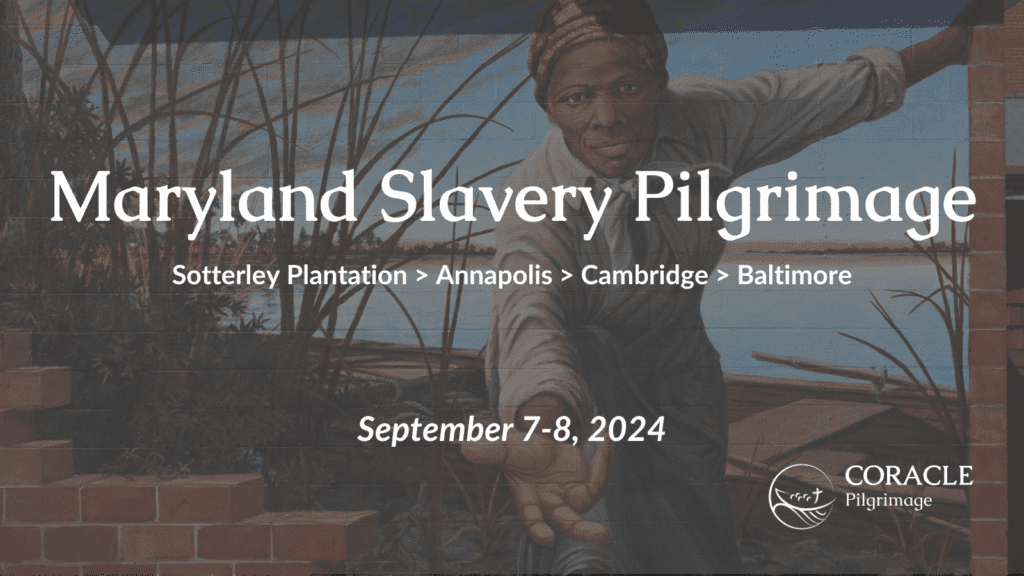
**Coracle is leading a Maryland Slavery Pilgrimage on September 7th & 8th (this event is full) and also a Racial History & Activism Pilgrimage in Arlington on October 19th. If you would like to learn more about future pilgrimages in Maryland and/or sign up for our upcoming Arlington pilgrimage click here!
Growing up with Czech and Irish relatives in rural and small-town Iowa has deeply formed my sense of who I am. We moved to Baltimore during grade-school and when my friends were eating hard shell crabs and going to the beach for summer vacation we made the trek back to Grandparent’s farm. I was raised in a predominantly white suburban neighborhood and went to school in predominantly white public schools. It wasn’t until I returned from living in Indonesia as an adult that I realized there was so much more to Baltimore than what I experienced growing up. I didn’t understand why Baltimore neighborhoods remain largely segregated and why some areas are so much poorer than where I grew up.
Then I was invited to teach 8th humanities at Cambridge School which included a two-month unit on the history of the Civil Rights Movement which has significant roots in Baltimore. I became aware that there was so much about the American story, the stories of entire groups of people who share the same regional roots with me and yet who have had a very different experience of what it means to live here.
What began as an engagement with books and documentaries became more personal as I began to ask my Black friends about their American stories. My ability to imagine a very different experience from mine was fueled by participating in an American Lament followed by the opportunity in 2019 to participate in pilgrimage exploring the legacy of slavery in Virginia. As my imagination was expanded, I grew in empathy, compassion, and grief over a very painful history that I had not seriously connected with before. One of the lasting gifts of that pilgrimage was a desire to learn more about Maryland and Baltimore in particular. We are the legacy of our ancestors. Their stories have shaped the contexts for our stories. I began to appreciate that to begin to truly comprehend why Baltimore looks the way it does today is to understand the stories of the people who live here now and how their context was shaped by the experiences of their ancestors.
Covid delayed the fruition of my hope to engage with Maryland’s formation and the centrality of chattel slavery to that formation but in the fullness of time God led me to Dr. Dale Green at Morgan State University who is an architect and the primary caretaker of historic African American sites in Maryland. I soon recognized that I had been ushered into a sacred space. Dr. Green led pilgrimages with John Lewis and has a deep desire to see the healing and repair that only Jesus can bring. His personal story includes direct familial ties to Harriet Tubman and Frederick Douglas. He confirmed my sense that the development of Maryland as an English colony and its formation as a state cannot be separated from our legacy with chattel slavery. The first enslaved Africans were brought to St. Mary City and the surrounding area with a few years of the first English speaking settlement in the 1630’s.
As the colony grew and the capital was moved to Annapolis so did the institution of slavery. Two iconic African American leaders were born into slavery on the Eastern shore of Maryland near the town of Cambridge and Frederick Douglass was sold to a family in Baltimore. I was not raised with an awareness of the slavery pens and the human auction blocks that were located on Pratt Street along the inner harbor of Baltimore.
So by God’s grace Dr. Green led a diverse group of friends of Coracle on a two day pilgrimage last September to these four critical sites. One of the humble gifts the Baltimore Coracle Facilitation team feels led to offer Baltimore is making this experience available to others from across the Baltimore region who are laboring to see God’s shalom and justice realized in our day. Dr. Angela Howell has taken the mantle that Dr. Green has entrusted to us and is leading a broader group of Christian leaders on this pilgrimage to these four sites this September 7th & 8th.
To know someone’s story is to move beyond stereotypes and false senses of knowing why our region with its diversity of neighborhoods looks the way it does today. To know someone’s story is to see a person as the image bearer of God that they truly are. Someone who shares my dreams, hopes, desires for love, peace, joy, and connection. Where there is human connection there is hope that we can become the beloved community Jesus desires for his sons and daughters and the places where they dwell.
